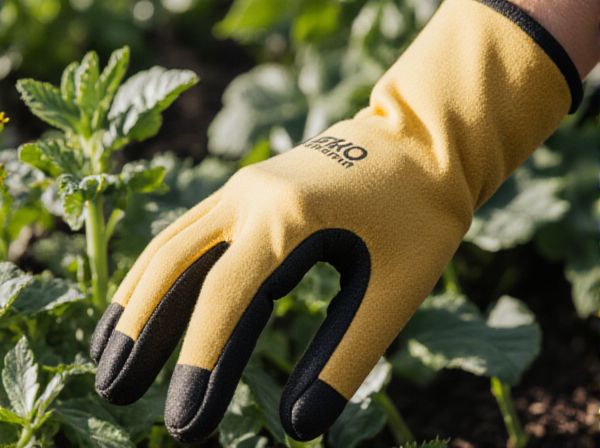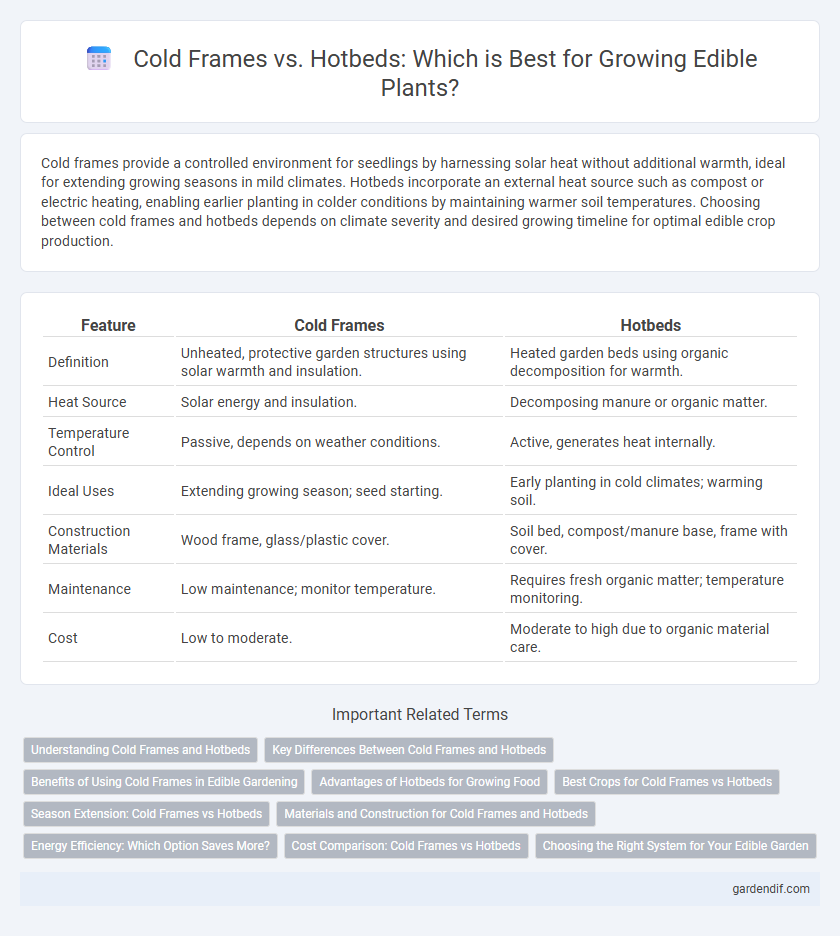
Cold frames vs Hotbeds Illustration
Cold frames provide a controlled environment for seedlings by harnessing solar heat without additional warmth, ideal for extending growing seasons in mild climates. Hotbeds incorporate an external heat source such as compost or electric heating, enabling earlier planting in colder conditions by maintaining warmer soil temperatures. Choosing between cold frames and hotbeds depends on climate severity and desired growing timeline for optimal edible crop production.
Table of Comparison
| Feature | Cold Frames | Hotbeds |
|---|---|---|
| Definition | Unheated, protective garden structures using solar warmth and insulation. | Heated garden beds using organic decomposition for warmth. |
| Heat Source | Solar energy and insulation. | Decomposing manure or organic matter. |
| Temperature Control | Passive, depends on weather conditions. | Active, generates heat internally. |
| Ideal Uses | Extending growing season; seed starting. | Early planting in cold climates; warming soil. |
| Construction Materials | Wood frame, glass/plastic cover. | Soil bed, compost/manure base, frame with cover. |
| Maintenance | Low maintenance; monitor temperature. | Requires fresh organic matter; temperature monitoring. |
| Cost | Low to moderate. | Moderate to high due to organic material care. |
Understanding Cold Frames and Hotbeds
Cold frames and hotbeds are essential gardening structures that extend the growing season by providing controlled environments for seedlings and plants. Cold frames rely on passive solar heating and insulation to maintain warmth, making them ideal for hardening off plants and starting seeds in mild conditions. Hotbeds incorporate an external heat source, such as decomposing manure or electric heating cables, to offer higher temperatures for early germination and growing heat-loving plants.
Key Differences Between Cold Frames and Hotbeds
Cold frames are simple, unheated structures that rely on solar energy to create a warmer microclimate for seedlings, while hotbeds use an external heat source such as buried manure or electric heating to maintain higher temperatures. Cold frames are ideal for extending the growing season in mild climates by protecting plants from frost, whereas hotbeds enable earlier planting and faster growth due to their controlled warmth. The main difference lies in the heat source and temperature regulation, with hotbeds offering more consistent and elevated heat compared to cold frames.
Benefits of Using Cold Frames in Edible Gardening
Cold frames in edible gardening extend the growing season by protecting plants from frost and maintaining a stable microclimate, ideal for seedlings and hardy vegetables. They reduce the need for artificial heating, lowering energy costs compared to hotbeds, which require a heat source such as decomposing manure. The simplicity and cost-effectiveness of cold frames make them an accessible solution for gardeners aiming to improve crop yield and plant health.
Advantages of Hotbeds for Growing Food
Hotbeds offer superior soil warmth through natural heat generated by decomposing organic matter, extending the growing season for vegetables and fruits. They accelerate seed germination and plant growth by maintaining consistent temperatures, even in cooler climates. Enhanced microbial activity in hotbeds improves nutrient availability, resulting in healthier, more productive edible crops.
Best Crops for Cold Frames vs Hotbeds
Cold frames are ideal for growing leafy greens, herbs, and cool-season vegetables like lettuce, spinach, and radishes due to their ability to protect plants from mild frost while providing ample ventilation. Hotbeds, on the other hand, are better suited for heat-loving crops such as tomatoes, peppers, and eggplants because their built-in heat sources create a warmer microclimate that promotes faster germination and early growth. Selecting cold frames or hotbeds depends on the target crop's temperature requirements and growth stage, maximizing yield and quality.
Season Extension: Cold Frames vs Hotbeds
Cold frames and hotbeds both extend the growing season by protecting plants from frost and cold temperatures, but they differ in heat management. Cold frames rely on solar energy and passive heat retention, ideal for late winter or early spring crops, while hotbeds generate additional warmth through decomposing organic matter, enabling earlier planting even in colder conditions. Choosing between them depends on desired temperature control and the specific crops needing season extension.
Materials and Construction for Cold Frames and Hotbeds
Cold frames typically feature wooden or metal frames with glass or plastic covers designed to trap solar heat, while hotbeds incorporate similar structures but include a heat source such as decomposing organic matter or electrical heating elements beneath the soil. Materials for cold frames need to be durable yet lightweight for easy relocation, often utilizing treated lumber and clear polycarbonate panels, whereas hotbeds require insulation materials like straw or foam boards to retain higher internal temperatures. Construction of cold frames emphasizes passive heat collection and ventilation, contrasted with hotbeds that integrate active heat generation and enhanced insulation to extend growing seasons.
Energy Efficiency: Which Option Saves More?
Cold frames use passive solar energy, relying on sunlight and insulation to maintain warmth, making them more energy-efficient for mild climates. Hotbeds generate heat through decomposing organic matter or electric heating elements, consuming more energy but providing consistent warmth in colder conditions. Choosing cold frames conserves energy, while hotbeds offer temperature control at a higher energy cost.
Cost Comparison: Cold Frames vs Hotbeds
Cold frames generally incur lower initial costs than hotbeds as they rely primarily on solar energy and simple construction materials like wood and glass. Hotbeds require an investment in heating elements such as electric cables or manure-based heat sources, increasing both setup and operational expenses. For budget-conscious gardeners, cold frames offer an economical option with minimal energy costs, while hotbeds provide accelerated growth at a higher financial commitment.
Choosing the Right System for Your Edible Garden
Cold frames provide a passive way to extend the growing season by trapping solar heat and protecting plants from cold weather, making them ideal for hardy vegetables and seedlings. Hotbeds incorporate a heat source, such as decomposing manure, to maintain warmer soil temperatures, perfect for more temperature-sensitive edible crops or early spring planting. Selecting between cold frames and hotbeds depends on your local climate, desired plant sensitivity, and the level of maintenance you can accommodate for optimal edible garden growth.
Cold frames vs Hotbeds Infographic

 gardendif.com
gardendif.com